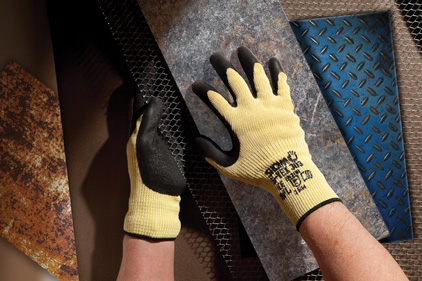In general, safety is not something that employers think of as a cost-saving measure. However, with the National Safety Council noting that there are 3.4 billion work-related injuries annually with $156.2 billion spent each year on work-related injuries, safety measures to avoid the cost of injuries become a viable budget consideration. Specifically to the question of hand protection, the U.S. Centers for Disease Control cite 1,080,000 hand injuries annually with visits to the emergency room. At the same time, there are 110,000 days annually away from work due to hand and finger lacerations.
Cut protection: a critical defense
With such a large number of hand injuries due to lacerations, cut protection is probably the single most important defense against hand injuries.
Fortunately, today’s cut-resistant work gloves are generations ahead of their predecessors of as recently as the 1990s. Today’s gloves are engineered not only for greater cut-resistance but also for fit and comfort. Lighter coatings, touch sensitivity, greater dexterity, and even oil absorbency are all being incorporated into leading cut-resistant gloves making them more task-specific and workers more effective. As a result, whether it’s slicing, cutting, shearing or sharp-edged handling, today’s cut-resistant hand protection selection options are the broadest and deepest ever. From stainless steel performance cut-resistant fibers to fiberglass aramids, there are cut-resistant gloves to meet every application. In addition, many of the newer glove models provide barrier protection and are engineered to the needs of particular tasks.
Cut-resistant fibers
Most safety officers are familiar with the many fibers used in cut-resistant personal protection equipment (PPE). But cut protection involves more than the base material of the glove. Factors such as the type of construction (types of weave and stitches per square inch), the thickness and type of coating and the basic weight of the fabric rather than the overall glove weight all factor into the glove’s
performance.
Among the most effective cut-resistant fibers are Kevlar®, Dyneema®, High Performance Polyethylene (HPPE) and new, patented Hagane Coil™ Technology. Coupling the basic cut-resistant fibers with stainless steel or fiberglass makes some of the strongest high performance yarns available to date:
- Aramids — Groundbreaking research by DuPont® scientists in the field of liquid crystalline polymer solutions in 1965 formed the basis for this fiber. Kevlar® is probably the best known brand in this fiber category. Other popular aramid brands include Novex® and Technora®. This high strength fiber was first used in the 1970s as a replacement for steel in racing tires. Among the industrial applications for gloves with an aramid basis fiber are glass handling, handling sharp metal objects, using razor knives, automotive assembly and handling hot objects. Kevlar cannot be bleached. It is broken down by bleach and also by fluorescent lighting. Kevlar can be laundered and dried using high temperatures.
- High Performance Poly Ethylene (HPPE) — This fiber is a subset of thermoplastic polyethylene. Dyneema® is one of the better-known brands of this engineered fiber. Among the industrial applications for gloves with an HPPE basis fiber are the same as the applications listed for Kevlar with the additional application of food handling. Dyneema fibers hold up very well to bleaching which makes them ideal for food handling since they can be bleached and reused. Dyneema and all HPPE fibers can melt and shrink if exposed to high heat, so they must be laundered and dried using medium temperatures and not hot temperatures.
- Kevlar/Stainless Steel —This long time favorite for cut resistance is now being combined with other cut-resistant fibers in some of today’s more reliable cut-resistant gloves. ANSI Cut Level 4 and 5 are achievable with the combination of these components. For example, in some gloves, a stainless steel core is woven with Dyneema or Kevlar for enhanced cut resistance. Among the industrial applications for gloves with a stainless steel core are the same areas listed before but with higher risk of cut injuries where a higher rated cut resistant glove is needed. Dyneema or Kevlar combined with stainless steel provides excellent protection for food handling applications where sharp knives are used.
- Hagane Coil Technology — A Hagane Steel core is embedded with a Kevlar® and polyester Hagane Coil wrap. The glove has a wrinkle finish and natural rubber latex or nitrile palm-coating. Hagane Coil technology affords users comfort and grip with ANSI Level 4 and 5 cut protection.
Cut-resistance testing
Cut-resistant gloves earn their title through stringent testing. There are three standardized methods for testing cut resistance:
- ASTM F1790 (U.S.)
- ISO 13997 (International)
- EN 388 (Europe)
Most U.S. cut-resistant glove specifications list the glove’s performance against the ASTM F1790 standard. In this testing process, the glove sample is cut with a TDM 100 or CPPT machine using a straightedge blade, under load, that moves along a straight path. When the blade cuts through the glove material, the machine cuts off and the distance the blade has travelled is recorded by the instrument. The sample is cut five times each at three different loads, low weights, medium weights and high weights. The data is collected and graphed to determine the required load (number of grams) to cut through the sample at a reference distance of 20 mm (0.8 in.) blade travel. This is referred to as the Rating Force or Cutting Force. The higher the Rating Force, the more cut-resistant the material.
Typically glove specifications will include icons such as bladed knives (one for each number in the cut level) as well as screws (one for each level of puncture resistance). Additionally, many cut-resistant gloves are tested for abrasion resistance.
The testing data is standardized for all cut-resistant gloves through the American National Standards Institute, which rates cut resistance from Level 0 to Level 5. The higher the level, the greater the cut resistance.
Employers are encouraged to use the following factors in cut-resistant glove selection:
- Choose glove with a higher ANSI cut rating for greater hazard protection
- Evaluate the glove’s suitability
- Evaluate past experiences with different gloves
- Select glove that minimizes risk of injury
- If injuries have occurred, choose a higher ANSI cut level glove
At the same time, it is essential to remind employees that “cut-resistant” does NOT mean “cut-proof.” Cut-resistant gloves DO NOT protect from rotating or moving blades. Serrated blades will catch on knitted gloves.
Some agents, such as bleach, will damage Kevlar® gloves. Heat will melt Dyneema gloves. Importantly, laundering instructions should be closely followed no matter which glove is being used.
The glove cannot do it all
Study after study shows that the most effective way of reducing most hand injuries is by wearing gloves. In fact, wearing gloves is found to reduce the relative risk of injury by 60 percent. Factors in the hand injury scenario are:
- Performing tasks with no gloves on
- Performing a task you are unaccustomed to performing
- Lack of training
- Distractions
- Fatigue
- Malfunctioning equipment or tools
- Rushing to get done
Making the right choice
More and more industrial employers are turning to the glove manufacturing community for help in selecting the right cut-resistant PPE for their employees. Most glove manufacturers now have programs to assess the cut-resistant glove requirements in a workplace and help employers get the best hand protection for their employees.




